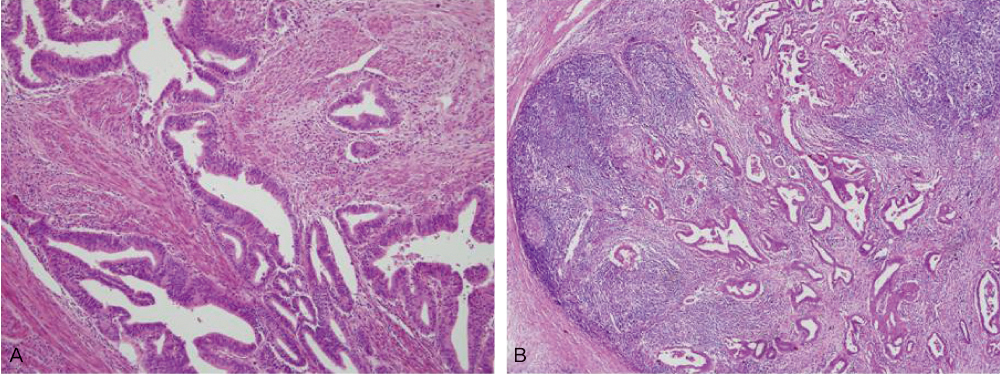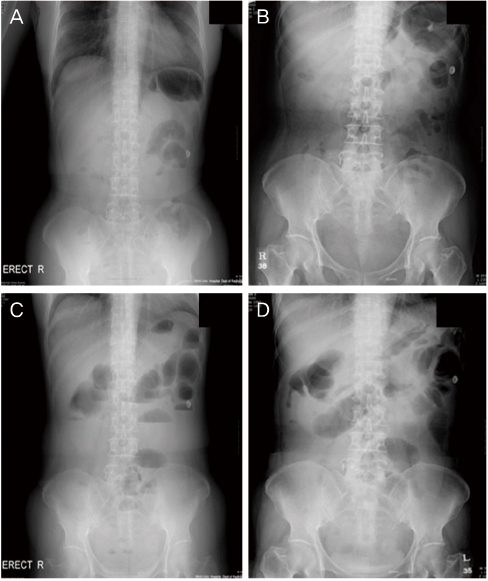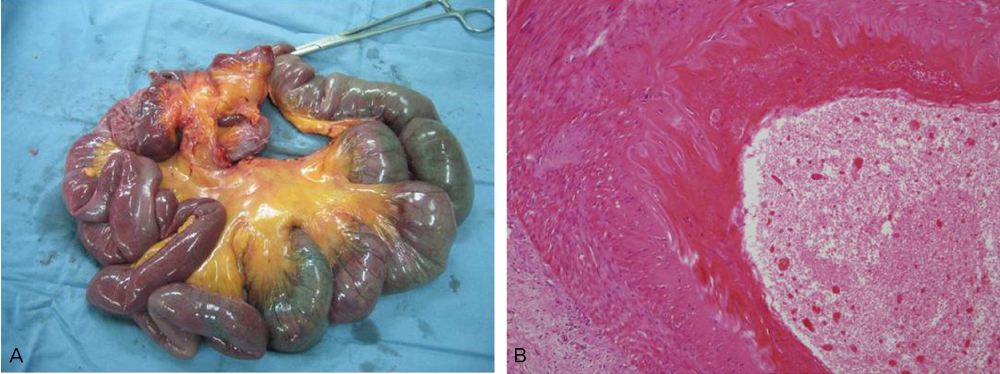Korean J Obstet Gynecol.
2011 Jun;54(6):317-321. 10.5468/KJOG.2011.54.6.317.
Concurrent chemoradiation-related superior mesenteric artery occlusion in the patient with advanced endometrioid endometrial cancer after surgery
- Affiliations
-
- 1Department of Obstetrics and Gynecology, Inha University College of Medicine, Incheon, Korea. songsong2000@hotmail.com
- 2Department of Surgery, Inha University College of Medicine, Incheon, Korea.
- 3Department of Radiation Oncology, Inha University College of Medicine, Incheon, Korea.
- 4Department of Pathology, Inha University College of Medicine, Incheon, Korea.
- KMID: 2274042
- DOI: http://doi.org/10.5468/KJOG.2011.54.6.317
Abstract
- The incidence of endometrial cancer (EC) has increased and it has approximately 16% of gynecologic cancers in Korea. For loco-regional or distant recurrence, adjuvant treatment after surgery is very important in patients with intermediate- or high-risk EC (IHR-EC). Recently clinical trials for treating patients with IHR-EC are focused on the efficacy of concurrent chemoradiation (CCR). However, increase in intestinal complications in the group of radiotherapy combined with chemotherapy was reported. In case of chemoradiation-related superior mesenteric artery (SMA) occlusion, it could be fatal nevertheless with intensive care. We present a case report of radiation-related arteritis leading to stenosis in SMA, which led the patient with EC to death in a year after CCR.
Keyword
MeSH Terms
Figure
Reference
-
1. Lee HP. Annual report of gynecologic cancer registry program in Korea: 1991~2004. Korean J Obstet Gynecol. 2008. 51:1411–1420.2. Creasman WT, Odicino F, Maisonneuve P, Quinn MA, Beller U, Benedet JL, et al. Carcinoma of the corpus uteri. FIGO 26th Annual Report on the Results of Treatment in Gynecological Cancer. Int J Gynaecol Obstet. 2006. 95:Suppl 1. S105–S143.3. Kuwabara Y, Susumu N, Banno K, Hirao T, Kawaguchi M, Yamagami W, et al. Clinical characteristics of prognostic factors in poorly differentiated (G3) endometrioid adenocarcinoma in Japan. Jpn J Clin Oncol. 2005. 35:23–27.4. Greven K, Winter K, Underhill K, Fontenesci J, Cooper J, Burke T. Final analysis of RTOG 9708: adjuvant postoperative irradiation combined with cisplatin/paclitaxel chemotherapy following surgery for patients with high-risk endometrial cancer. Gynecol Oncol. 2006. 103:155–159.5. CliniclaTrials.gov. Comparison of radiation therapy with or without combination chemotherapy following surgery in treating patients with stage I or stage II endometrial cancer [Internet]. 2008. cited 2008 Nov 12. Bethesda (MD): National Library of Medicine (US);Available from: http://clinicaltrials.gov/ct2/show/NCT00006027?%20term=RTOG+9905&rank=1.6. ClinicalTrials.gov. Chemotherapy and radiation therapy compared with radiation therapy alone in treating patients with high risk stage I, stage II, or stage III endometrial cancer [Internet]. 2008. cited 2008 Nov 12. Bethesda (MD): National Library of Medicine (US);Available from: http://clinicaltrials.gov/ct2/show/NCT00411138?term=PORTEC-3&rank=1.7. Kuoppala T, Mäenpää J, Tomas E, Puistola U, Salmi T, Grenman S, et al. Surgically staged high-risk endometrial cancer: randomized study of adjuvant radiotherapy alone vs. sequential chemo-radiotherapy. Gynecol Oncol. 2008. 110:190–195.8. Creutzberg CL, van Putten WL, Koper PC, Lybeert ML, Jobsen JJ, Wárlám-Rodenhuis CC, et al. PORTEC Study Group. Post Operative Radiation Therapy in Endometrial Carcinoma. Surgery and postoperative radiotherapy versus surgery alone for patients with stage-1 endometrial carcinoma: multicentre randomised trial. Lancet. 2000. 355:1404–1411.9. ASTEC/EN.5 Study Group. Blake P, Swart AM, Orton J, Kitchener H, Whelan T, Lukka H, et al. Adjuvant external beam radiotherapy in the treatment of endometrial cancer (MRC ASTEC and NCIC CTG EN.5 randomised trials): pooled trial results, systematic review, and meta-analysis. Lancet. 2009. 373:137–146.10. Kim JH, Lee SJ, Bae JH, Lee SH, Bae SN, Namkoong SE, et al. Adjuvant therapy in high-risk early endometrial carcinoma: a retrospective analysis of 46 cases. J Gynecol Oncol. 2008. 19:236–240.11. Hogberg T. Adjuvant chemotherapy in endometrial carcinoma: overview of randomised trials. Clin Oncol (R Coll Radiol). 2008. 20:463–469.12. Randall ME, Filiaci VL, Muss H, Spirtos NM, Mannel RS, Fowler J, et al. Randomized phase III trial of whole-abdominal irradiation versus doxorubicin and cisplatin chemotherapy in advanced endometrial carcinoma: a Gynecologic Oncology Group Study. J Clin Oncol. 2006. 24:36–44.13. Andros G, Schneider PA, Harris RW, Dulawa LB, Oblath RW, Salles-Cunha SX. Management of arterial occlusive disease following radiation therapy. Cardiovasc Surg. 1996. 4:135–142.14. Chuang VP. Radiation-induced arteritis. Semin Roentgenol. 1994. 29:64–69.15. Ting AC, Cheng SW, Yeung KM, Cheng PW, Lui WM, Ho P, et al. Carotid stenting for radiation-induced extracranial carotid artery occlusive disease: efficacy and midterm outcomes. J Endovasc Ther. 2004. 11:53–59.
- Full Text Links
- Actions
-
Cited
- CITED
-
- Close
- Share
- Similar articles
-
- One Case Report with the Occlusion of the Superior Mesenteric Artery and Left Renal Artery Complicated in the Mitral Stenosis
- A Case of Superior Mesenteric Artery Thrombosis Treated with Intra-arterial Urokinase Infusion and Intraluminal Stent Insertion
- Thrombectomy of Superior Mesenteric Artery Occlusion: A case report
- Case Report: Superior Mesenteric Artery Syndrome following Laparoscopic Adjustable Gastric Banding
- Clinical analysis of superior mesenteric artery occlusion





